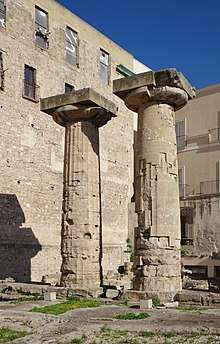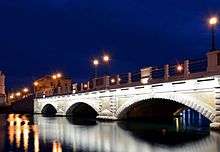Taranto
Taranto (Tarantino: Tarde) is a city on the Ionian coast of Apulia, in southeastern Italy. With 200,000 inhabitants it is the third-largest city of Southern Italy and the second-largest city of the region, after the capital Bari. Taranto is home of one of the most important naval bases in Italy and it boasts a thousand-year-old history, having been one of the most powerful cities of the Mediterranean during the Greek period.
Understand
History

Taranto was founded in 706 BC by Dorian Greek settlers, as the only Spartan colony outside of Greece (the town is still called "the Spartan city"). A legend gives the credit of the city's foundation to Taras (Τάρας) who, according to Greek mythology, was the son of Poseidon and of the nymph Satyrion; after being saved from a shipwreck by riding a dolphin, sent to him by his father, an image visible on many ancient coins.
The city, effectively named Taras, became soon a commercial and militar power of the Ancient Greek world, as well as the most important and inhabited centre of Magna Graecia. Its golden age finished in 272 BC, with the conquest by the Romans, that chose to favor Brindisi as the main port of the Roman Empire.
The town, now called Tarentum, fell in a period of decline and it was later contested between the Lombards, the Byzantines and the Arabs, being attacked and ransacked several times. It was then conquered by the Normans, that made it the capital of the Principality of Taranto, an almost independent feudal fief of the Kingdom of Sicily (and later of Naples), from 1088 to 1465.
The city was later governed by the Monarchy of Spain (for two centuries) and by the Bourbons, that created the Kingdom of the Two Sicilies in 1815. Taranto had a population of about 18,000 inhabitants, all of them living in the small island of the old town.
After the Italian unification, the city became the main base of the newly formed Italian Navy in 1866, and site of important events like the "Battle of Taranto" in 1940, with the victory of the British naval forces against the Italian ones. An enormous steel mill was built not far from the city centre, causing a controversy that lasts still today, making the town famous only for its industry.
Despite this, Taranto is not only a steel mill, but a place worth visiting with an high amount of artistic and historical treasures.
Tourist information
![]()
Get in

By plane
- 🌍
Brindisi Airport (BDS IATA known as Aeroporto del Salento), Contrada Baroncino, ☎ +39 0831 411 7406. It's the closest airport to Taranto, at about 70 km (43 miles) through

- 🌍 Bari Karol Wojtyła Airport (BRI IATA), Viale Enzo Ferrari, ☎ +39 080 580 0200, toll-free: +39 800 949 944. It represents another option to reach Taranto, mainly because of the higher number of destinations available; it's a little further, at 100 km (62 miles) through the Adriatic motorway. There are approximately 40 various cheap flights into Bari from various European airports.
There are discount flights available from London, Rome, Milan, etc. For a complete list, check out the website of Apulian airports.
By train
By car
The ![]()
- From Rome:




- From Naples: cross the Basilicata region through




- From Lecce: drive along



By bus
The 🌍 bus terminal is located in Via Cristoforo Colombo, close to the commercial port and few steps away from the stone bridge of Via Napoli. You can reach Taranto from various cities of Italy, France, Germany and Switzerland thanks to different private bus agencies:
- Buscenter from Bologna, Catania, Milan, Turin, Palermo and other Sicilian towns.
- Flixbus from 76 destinations in Italy and Europe such as Florence, Genoa, Matera, Milan, Munich, Nuremberg, Pescara, Pompeii, Rome, Venice.
- Marino Bus from Bologna, Foggia, Frankfurt, Lucerne, Milan, Naples, Stuttgart, Turin, Zurich and other localities.
- Marozzi from Bari, Brindisi, Florence, Pisa, Rome, Siena.
- Miccolis from Caserta, Matera, Naples, Pompeii, Potenza, Salerno.
- Ouibus from Bologna and Milan.
Almost all the routes from abroad requires a transfer in Milan or Bologna. Fares can drastically change according to the period and even the day chosen.
By boat
Get around
By bus
AMAT is the company that manages the local bus transport system. A single ticket (biglietto ordinario) can be purchased at every tobacconist and newspaper seller for €1, or it can be bought on board for €1.50 and it is valid for a single ride. You can also choose a ticket valid for 90 minutes (€1.30), a 1-day solution ticket (€2.60), a 3-days ticket (€6.50) or a 7-days ticket (€15.50).
By car
On foot
See
Taranto has a beautiful Cathedral and a stunning fishing port, with fantastic theatres, nightlife and gorgeous cuisine- scrumptious! Well worth a visit!
- 🌍 Aragonese Castle, Piazza Castello, ☎ +39 099 775 3438, e-mail: infocastelloaragonese@libero.it. 09:30-11:30/14:00-18:00/20:00-01:30.
- 🌍 Cathedral (Cattedrale di San Cataldo), Piazza Duomo, ☎ +39 099 470 7545. 07:30-12:00/16:30-19:30. Free entry.
- 🌍 Temple of Poseidon (Doric Temple), Piazza Castello. Two doric columns represent the remains of this ancient Greek temple, dedicated to the god of the seas. It dates to the 6th century BC and was unfortunately victim of spoliation during the centuries. The columns stand at 8.47 meters (28 ft) above the ground, in front of the city hall, and they can be admired from behind a gate.
- 🌍 Church of San Domenico Maggiore, Via Duomo, 33, ☎ +39 099 707 733. Romanesque-Gothic church built in 1302 over the site of a Byzantine church of the 11th century, built, in turn, on an ancient Greek temple. The entry is reachable through a Baroque staircase erected in the 18th century. Free entry.
- 🌍 National Archaeological Museum (MArTA), Via Cavour, 10, ☎ +39 099 453 8639, e-mail: prenotazioni@novaapulia.it. 08:30-19:30. €8 full; €4 reduced; Free up to 18 years and every month's first Sunday.
- 🌍 Spartan Museum (Museo Spartano), Corso Vittorio Emanuele II, 39, ☎ +39 330 438 646, e-mail: museospartanotaranto@gmail.com. Su 11:00-13:00, other days on reservation.
Do
Buy
Eat
Budget
Mid-range
Splurge
Drink
Sleep
Budget
Mid-range
Splurge
- Relais Histo', Via Santandrea Circummarpiccolo, ☎ +39 099 4721188, fax: +39 099 6410290, e-mail: info@relaishisto.it.
Connect
Stay safe
Cope
Go next
- Alberobello – its world-famous characteristic white "trulli". (40 min by car)
- Brindisi – relevant Romanesque churches and port with ferries to Albania and Greece. (45 min by car)
- Lecce – the triumph of the Baroque architecture in the heart of Salento peninsula. (1 hr by car)
- Matera – the suggestive scenario of its "sassi" definitely worth visiting (1 hr by car)
- Ostuni – the famous "white town" can be discovered after 45 minutes of driving.
| Routes through Taranto |
| Bologna ← Rimini ← Ancona ← Pescara ← Bari ← | N |
→ END |
| Rome ← Caserta ← Potenza ← Matera ← | W |
→ Brindisi |
| END ← | N |
→ Lecce |
| Bari ← Fasano ← Alberobello ← Locorotondo ← | N |
→ END |
| END ← Fasano ← Alberobello ← Locorotondo ← | N |
→ Metaponto → Policoro → Roccella Ionica → Reggio Calabria |